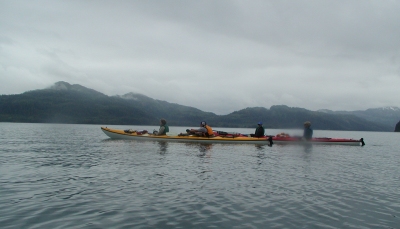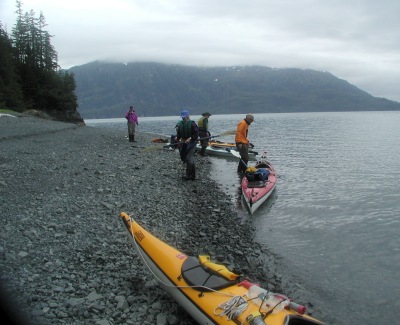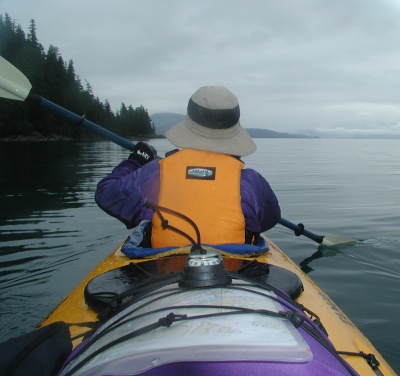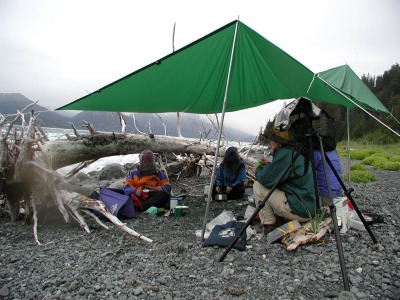Glacial Thunder: Sea Kayaking
in Prince William Sound 2001
Susie's birthday - around Dual Head
Tuesday, August 14 This was our "big day." 12 miles around Dual Head, and more out into open water than either of us had been. 12 miles of paddling to move about a mile and a half on the map. We awoke to a very low ceiling: it seemed that the fog had robbed us of our blue skies. With virtually no wind this morning, the bugs were wild, and searching hard for any exposed flesh. As we were cooking breakfast, it occurred to me that actually, I might have a spare bug net, and with that spare, I also had one that was in my "deep safety" kit (the one I hope I never need to get into). I don't know why this information had occurred to me now, on our fourth day of the trip. Maybe it was watching Tim and Diane swat bugs, or just look miserable. I quickly walked back to our tent, and sure enough, after digging through my gear, I was holding two separate bug nets. I walked back to the group, and presented them each with a net. I have never seen such a look of gratefulness on anyone's face. Tim told me later in the day that he would have paid a thousand dollars for a bug net that morning. I think I might have said something to the effect that he got a real deal then. They were miserable this morning, and I even wore my fingerless kayaking gloves to cover some of my exposed hands.
 We packed up our boats, being encouraged to leave by our winged friends, and were on our way by 9:37 am. Most of us left our bug nets on for the first hour of paddling: the persistent little creatures would not give us any peace. Starting back up the long arm of Humpback Cove, we could see the usual compliment of bald eagles. I don't thing I have seen so many of these birds in such a short period of time: both mature and immature eagles. Susie commented that we seemed to be moving at a steady, and not-falling-behind pace. I attributed it to all the good fish protein I had been consuming. We rested after about an hour's paddle, just stretching, and watching for whales and otters. We started rounding Dual Head, and saw our first party of kayakers camped since we started the trip. It was already 11 am, and they seemed to be just finishing up breakfast. Of course, with the Alaskan daylight, one can finish breakfast at 3 pm and still get a full day's paddle in. We had not gone too much further, and it seemed to be a nice time to get out and pee. I was grateful that my bladder capacity was not-atypical of the group. In fact, it seemed that I was is less discomfort than many of the paddlers, most of the time, bladder-wise. I declared that for me, this was lunch. The food was easy to get to, and I could see that if the progress we were making kept up, it would be another two hours before anyone wanted to stop, and then we would be at camp. The clouds remained, but at where we were beached, there was little breeze. My polartek T-shirt and wind shirt (combined of course, with my PFD) seemed to offer all the warmth I needed.
We packed up our boats, being encouraged to leave by our winged friends, and were on our way by 9:37 am. Most of us left our bug nets on for the first hour of paddling: the persistent little creatures would not give us any peace. Starting back up the long arm of Humpback Cove, we could see the usual compliment of bald eagles. I don't thing I have seen so many of these birds in such a short period of time: both mature and immature eagles. Susie commented that we seemed to be moving at a steady, and not-falling-behind pace. I attributed it to all the good fish protein I had been consuming. We rested after about an hour's paddle, just stretching, and watching for whales and otters. We started rounding Dual Head, and saw our first party of kayakers camped since we started the trip. It was already 11 am, and they seemed to be just finishing up breakfast. Of course, with the Alaskan daylight, one can finish breakfast at 3 pm and still get a full day's paddle in. We had not gone too much further, and it seemed to be a nice time to get out and pee. I was grateful that my bladder capacity was not-atypical of the group. In fact, it seemed that I was is less discomfort than many of the paddlers, most of the time, bladder-wise. I declared that for me, this was lunch. The food was easy to get to, and I could see that if the progress we were making kept up, it would be another two hours before anyone wanted to stop, and then we would be at camp. The clouds remained, but at where we were beached, there was little breeze. My polartek T-shirt and wind shirt (combined of course, with my PFD) seemed to offer all the warmth I needed.
 We had joked about zipping across the bay to the village of Chenega (on the island similarly named) and enjoying a cold brewski with lunch. Subsequent reading and map study indicated that the village had been abandoned for some time. The reason: In the Good Friday earthquake of 1964 (the second most powerful ever recorded on the planet), the village was struck by a tsunami that was more than 85 feet high. The tidal wave killed 23 people in the small village, and the town was destroyed. A sad ending to a place on the map.
We had joked about zipping across the bay to the village of Chenega (on the island similarly named) and enjoying a cold brewski with lunch. Subsequent reading and map study indicated that the village had been abandoned for some time. The reason: In the Good Friday earthquake of 1964 (the second most powerful ever recorded on the planet), the village was struck by a tsunami that was more than 85 feet high. The tidal wave killed 23 people in the small village, and the town was destroyed. A sad ending to a place on the map.
Back in the boats, we noted out to our right (I am not going to use this port and starboard stuff) at the head of Icy Bay several spouts from whales. At the distance we were at, we could not see any tails up in the air, but it was nice to know they were around. As we completed our rounding of Dual Head, it seemed like the weather changed. The wind picked up, and the air temperature must have dropped about 10 degrees. I think we were feeling cold air flowing off the glaciers. The water picked up a little chop, but nothing too bad. Our next challenge was the ice. I head read somewhere that paddling in this region of the sound can sometimes be like paddling through a frozen margarita. On the rocks, at least. We came into an area, maybe a third of a mile in "thickness" where we decided single file was the most prudent approach. This is when Susie really got into her "Right!! Right!! No, the OTHER Right!" routine. It is interesting to note how much of the dead ahead view that the front paddler obstructs from the rear paddler. Susie seemed to be always amazed about a chunk of ice that was close to us that I just could not see. We were particularly wary of the ice, since these were fiberglass boats, more fragile than plastic. It would have been a bad place to develop a serious leak. Once through the "ice field" (more an exercise in steering than any real danger, since most of the bergs would be classified as micro-icebergs: more furniture sized than room sized), we picked up our pace again. We went through a brief shower, and then, as we got nearer to bigger icebergs across the bay from us, we started noticing the larger bergs speckled with black. The black specks turned out the be seals, just resting, or doing whatever they do when they are not swimming.
 We were nearing a long beach on the east side of Icy Bay, across from the mouth of Nassau Fjord. Diane and Tim pulled up to it, and Diane seemed to think that this was the place that we had camped at before. Based on my recollection of the maps, it seemed pretty close to me. It had water, and a nice long beach: we were home. Our next challenge was to actually find a place to beach. With the tide receding, and the Chenega and Tiger Glaciers calving like crazy, our beach was littered with ice bergs. We really needed to find a spot that was wide enough to get all four of the kayaks in cleanly. We paddled south for a hundred yards or so, and pulled in along side a room-sized iceberg. It was just shortly after 2 pm. For all our concerns about "our big day," we had managed to knock it off in less than 4.5 hours, including a stop for lunch. Susie and I found a semi-flat spot right at the edge of the vegetated area, while Dave, as usual, parked his tent as close to the high tide line as he dared. T&D were back in the woods a bit, and A&S were not too far from us. This seemed to be the usual tent configuration on the trip to date. Since it was Susie's birthday, I declared that she needed to have a warm-water, in-tentia bath. It certainly did not take much arm twisting: it was a cool, cloudy afternoon, with plenty of time to photograph and poke around later: why not take a hot bath now. So I got her all set up, and when she finished with the pots, I trundled north up the beach a couple of hundred yds to a big creek. My bath would not be as warm, but I would get to use a lot more water.
We were nearing a long beach on the east side of Icy Bay, across from the mouth of Nassau Fjord. Diane and Tim pulled up to it, and Diane seemed to think that this was the place that we had camped at before. Based on my recollection of the maps, it seemed pretty close to me. It had water, and a nice long beach: we were home. Our next challenge was to actually find a place to beach. With the tide receding, and the Chenega and Tiger Glaciers calving like crazy, our beach was littered with ice bergs. We really needed to find a spot that was wide enough to get all four of the kayaks in cleanly. We paddled south for a hundred yards or so, and pulled in along side a room-sized iceberg. It was just shortly after 2 pm. For all our concerns about "our big day," we had managed to knock it off in less than 4.5 hours, including a stop for lunch. Susie and I found a semi-flat spot right at the edge of the vegetated area, while Dave, as usual, parked his tent as close to the high tide line as he dared. T&D were back in the woods a bit, and A&S were not too far from us. This seemed to be the usual tent configuration on the trip to date. Since it was Susie's birthday, I declared that she needed to have a warm-water, in-tentia bath. It certainly did not take much arm twisting: it was a cool, cloudy afternoon, with plenty of time to photograph and poke around later: why not take a hot bath now. So I got her all set up, and when she finished with the pots, I trundled north up the beach a couple of hundred yds to a big creek. My bath would not be as warm, but I would get to use a lot more water.
 After bathing, I returned to the tent, and offered Susie a cup of wine (joining her, of course) to go with the snacks that we were sorta behind schedule on eating. It was nice to be out of the bugs completely, and I could ponder how to erect a dining tarp, given the threat of rain. To put it mildly, we were well tarped for this trip. Susie and I had our awning tarp, which is not large, but fits nicely over our tent and provides some additional cooking shelter. Then we had this large three-sided contraption, complete with bug net door, and in addition, we had purchased a 14' x 10' flat tarp, to add a "porch" to our three sided tarp. Sue reported that they had a tarp as well, although I never saw it. We had brought 4 poles, plus, we could use the paddles to provide additional support if needed. Susie had the idea, since it did not seem to want to rain hard, just mist slightly, to use a large beached tree to support part of our 14 x 10 tarp, and with the poles on the other end, we might get by with a simple one-tarp erection. With all the extra hands available as I emerged from the tent, it was up in short order. It was a bit of a squeeze for all of us, but Dave seemed to be helping out Fuji again, so the three couples could get two stoves up and running for dinner. Susie's birthday dinner was Hamburger Helper Beef Stroganoff (I wanted something that would actually go with our red wine), and for dessert, I baked a chocolate cake in our Bakebacker. I had warmed the icing so it would spread, and it got so thin that I had to set it on top of a small chuck of ice to cool it down. I guess the little bergs do come in handy. As we were cleaning up after dinner, Sue noticed a fin come up our of the water: it was a killer whale going right by our camp. It was clearly cruising right below the surface, and just off the beach. It got about 130 yards north of camp, and jumped completely out of the water. What a great memory for Susie's birthday. You could not have planned it any better. It finally started misting significantly, indicating it was time for bed. The views from this campsite: Chenega Glacier to the northwest, Tiger Glacier to the south, almost non-stop glacial thunder, not so much in the distance now, and the sea otters cruising by continuously to keep an eye on us, made you want to stay up, despite the tiredness and the weather.
After bathing, I returned to the tent, and offered Susie a cup of wine (joining her, of course) to go with the snacks that we were sorta behind schedule on eating. It was nice to be out of the bugs completely, and I could ponder how to erect a dining tarp, given the threat of rain. To put it mildly, we were well tarped for this trip. Susie and I had our awning tarp, which is not large, but fits nicely over our tent and provides some additional cooking shelter. Then we had this large three-sided contraption, complete with bug net door, and in addition, we had purchased a 14' x 10' flat tarp, to add a "porch" to our three sided tarp. Sue reported that they had a tarp as well, although I never saw it. We had brought 4 poles, plus, we could use the paddles to provide additional support if needed. Susie had the idea, since it did not seem to want to rain hard, just mist slightly, to use a large beached tree to support part of our 14 x 10 tarp, and with the poles on the other end, we might get by with a simple one-tarp erection. With all the extra hands available as I emerged from the tent, it was up in short order. It was a bit of a squeeze for all of us, but Dave seemed to be helping out Fuji again, so the three couples could get two stoves up and running for dinner. Susie's birthday dinner was Hamburger Helper Beef Stroganoff (I wanted something that would actually go with our red wine), and for dessert, I baked a chocolate cake in our Bakebacker. I had warmed the icing so it would spread, and it got so thin that I had to set it on top of a small chuck of ice to cool it down. I guess the little bergs do come in handy. As we were cleaning up after dinner, Sue noticed a fin come up our of the water: it was a killer whale going right by our camp. It was clearly cruising right below the surface, and just off the beach. It got about 130 yards north of camp, and jumped completely out of the water. What a great memory for Susie's birthday. You could not have planned it any better. It finally started misting significantly, indicating it was time for bed. The views from this campsite: Chenega Glacier to the northwest, Tiger Glacier to the south, almost non-stop glacial thunder, not so much in the distance now, and the sea otters cruising by continuously to keep an eye on us, made you want to stay up, despite the tiredness and the weather.
© Roger A. Jenkins & Suzanne A. McDonald, 2001
